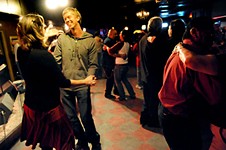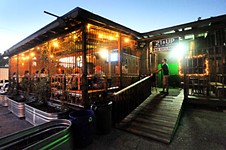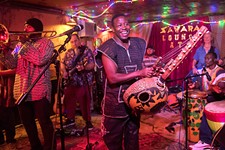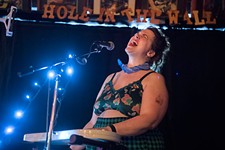Behold a Pale Horse: the White Horse Turns Ten with No Signs of an Apocalypse
A look back at the early days of the “black sheep” of Austin honky-tonks
By Gary Lindsey, 12:30PM, Fri. Dec. 10, 2021
Humble beginnings are all but mandatory in a good country song. You’re not going to hear many references to growing up with butlers, maids, or mansions on a Johnny Cash record and Merle Haggard never sang a ballad about the challenges of finishing a masters degree.
”I had ZERO dollars, which was exactly how much Nathan had as well,” Denis O’Donnell says of his life before owning the White Horse, the popular Eastside two-step staple, which celebrates its tenth anniversary this week with a series of concerts.
He and co-owner Nathan Hill met in the mid-2000s working at Kerbey Lane Cafe on South Lamar.
“I distinctly remember the first time I met [O’Donnell] in the office,” says Hill. “With his big ol goofy glasses, slick Fifties haircut, and a super floral pearl snap – honestly I thought, right off the bat, he was too nice to last there, but I quickly realized he was just a really friendly and kind guy with an incredible work ethic.”
Right away, the two realized they had a lot in common, not just in regards to hard work, but how you treat your fellow employees.
“We both always believed in treating everyone fair and equitably, and that hospitality starts first with kindness to the staff,” Hill recalls.
Eventually, Hill left Kerbey Lane Cafe to work at another legendary Austin haunt, the Hole In The Wall. About six months later, he received a call from O’Donnell informing him that he was also no longer employed at the popular eatery.
“The day I got fired from Kerbey Lane I shaved my head into a mohawk and went from running a $2 million-a-year business, with five managers and over 100 employees, to mopping throw-up in the men’s bathroom at the Hole In The Wall,” O’Donnell states. “And it was liberating.”
Apparently O’Donnell was pretty good with that mop because he quickly became a manager and was given free reign to book the front room for happy hour. In addition to a strong work ethic, he seemed to also have pretty good timing.
”I was just lucky that a lot of the bands that I was booking for happy hour were fucking phenominal,” O’Donnell says, citing acts like the Carper Family, John Evans, Country Willie Edwards, Mike & the Moonpies, the Bridgefarmers, Clyde & Clem's Whiskey Business, and Bankrupt & the Borrowers.
“There were punkers and country dudes all mish-mashed together,” O’Donnell recalls, “A lot of those nights spilled over to my house.”
That, of course, is exactly where the lines get blurry, in more ways than one, between booking the bands and playing in them.
“As O’Donnell started to take on booking his own happy hour shows – the infamous East Cameron Tuesday nights and the very successful local country Monday nights – I think we started to realize we had found a niche we could really help flourish in town,” Hill says.

The two knew that they had the right chemistry to create something special, but without a dime to their name, or any property to lien against, they knew that it would come down to one single option, finding investors: a drawn out, maddening process that repeatedly fell apart at the finish line for various reasons. One interested party even told them he would be willing to put up $140,000 – all they had to do was go down to Mexico, strap it to their chest, and walk it back over the Rio Grande into Texas.
They respectfully declined.
It seemed that they were destined to spend the rest of their lives running other people’s businesses when the two finally caught a break in the form of an unassuming regular customer. Like most people, Marshall McHone had grown friendly with Denis while coming in to support his daughter Carson, who was a regular performer there. Upon hearing about O’Donnell’s latest misfire at opening his own place, he – to everyone’s great surprise – offered to help.
“I didn’t think he had any money, he drives an old truck and he wears an old flannel,” O’Donnell says of McHone, a veteran of Austin’s bar industry. “He seemed like me, a workin dude.”
Salvation in an old flannel and a beat up truck – if that’s not the makings of a great country song, what is?
Once the check cleared, O’Donnell, Hill, and a rag-tag group of charitable souls set in on the old Club La Trampa space on Comal and Fifth Street with power tools and paint brushes to make their mark – not that there were too many changes to be made. Much like the music scene they’d been cultivating for years, preservation was just as much of a priority as rejuvenation.
Mike Harmeier of Mike & the Moonpies remembers: “We went over and painted the walls. My wife designed the sign. Denis has been family to me since we started playing at the Hole In the Wall…my whole life was based around those people when the White Horse opened.”
Beth Chrisman of the Carper Family and Missy Beth & the Morning Afters recalls the pre-opening days of the White Horse: “I went to a lot of the early meetings about where the stage should be and what you need…what would make this place good for musicians. It was really cool to have a bar ask that before they opened.”
It was that kind of mutual respect that enabled the Comal Street honky-tonk to hit the ground running like an old Chevy van with fresh tires and a rebuilt transmission. The White Horse became an instant classic, despite opening without the liquor license secured.
“We booked this big show with all of the homies,” remembers O’Donnell, “And we weren’t going to not have the show just because we couldn’t have drinks. The bar next door literally ran out of liquor because people were just going over there, doing shots, and going back to the show.”
And with that, on December 9, 2011, the White Horse had arrived.
Giving shelter and a stage to an unrestrained and unleashed version of roots music that wasn't having any luck with the old guard, they quickly found opportunity in the fact that tourist-enticing destinations like the Continental Club and the Broken Spoke were locked down tight with solid long-term residencies and people looking specifically for a night of Bob Wills and Lefty Frizzell covers.
“When you have residencies with Johnny Cash’s piano player and Merle Haggard's lead guitar player, you’re not gonna be able to wiggle your way in there easy,” O’Donnell says.
This frustration, and a sixth sense for raw talent, helped O’Donnell to focus on his instincts for good music and sincerity on the surrounding multitude of young, eager bands who had far more heart and originality than credentials. The business made such a mark in its first 12 months that a year-end music wrap in the Chronicle declared 2012 to have been “The year of the White Horse.”
Much like a child spawned out of wedlock trying to join it’s biological family late in life, the White Horse shares a DNA with its iconic predecessors, but also has a noticeable dose of, “Boy, you ain't right!” This graceful balancing act could be well summarized by a hilarious bottle-smashing, television-exploding, obscenity-laced silly promotional video for venue’s happy hour in 2014, which hit YouTube shortly before the high-budget music video of Kacey Musgraves and Willie Nelson’s song “Are You Sure,” which was also filmed at the White Horse. Somehow, the disparate clips look as natural as longhorns fastened to the grill of a Seventies Cadillac.
Some things don’t have to make sense to work.
For the next week and some more, the White Horse will be celebrating the past ten years with anniversary concert series, which began Thursday night with a show headlined by Mike & the Moonpies. The run of gigs – including performances by Vincent Neil Emerson, Conjunto Los Pinkys, Dave Insley, Clyde & Clem’s Whiskey Business, Kathryn Legendre, and Brennen Leigh – reflect the broad spectrum of friendships, residents, and inspirations that helped bring O’Donnell and Hill’s dreams to life.
Busty Morris, who’s helmed the music calendar at the White Horse for the last four years as the venue’s booker, remembers his initial observations of the honky-tonk in its early days, when he’d come with coworkers at a local mechanic shop.
“You saw 21-year-olds through 80-year-olds – every color, every orientation, every kind of person – in there dancing,” he says. “We were a bunch of rough, tattooed mechanic guys and they welcomed us with open arms. It’s a special place. Everything falls away when you’re there. There’s nothing bad when you’re at the White Horse.”
As the booker, Busty oversees many long-lasting residencies, but also enthuses over the venue’s openness to experiment with new acts, which he characterizes as “throw stuff at the wall to see what sticks.”
“We’re the black sheep of dance halls,” he reasons. “We like the bands that are too loud for other country bars. We want the bands that burn the paint off the walls.”
Austin musician Corey Baum is playing twice throughout the White Horse’s decade celebration – tonight (Friday) leading his Marxist honky-tonk act Croy & the Boys and next Thursday playing bass with country songwriter Leo Rondeau, who he began playing at the Horse with in 2013. It was then that he’d begun seeing the significance of the White Horse’s musical identity.
“There was obviously something percolating in underground country music in the last ten years with people like Sturgill Simpson and Margo Price – in Austin, that was spread around the city, but the White Horse gave it a nucleus,” Baum assesses. “I think that’s why Austin has such a strong identity in that scene. People all over the country know the White Horse and, when we go on tour, it’s really common for us to end up in places where people tell us the bar we’re paying was inspired by the White Horse. It put a stamp on the culture for sure.”
Still, Nathan Hill couches “success” as a relative term – and not immediate marker – for the bar.
“From my point of view, I wouldn't say it was overnight. There was a lot of growth through pain and sweat and tears over the years,” Hill says. “I don't think I ever really looked back and thought ‘We did it’ until maybe year five or six. Having a room full of dancers and drinkers is one thing, learning how to keep that machine running seven days a week for years on end is another.”
Asked what he’s enjoyed the most about this personal journey of hard work and good intentions, Hill responds simply: “My favorite part is seeing a place running on all cylinders with a room full of folks having a great time. Those are my favorite moments. Sitting in the corner and watching people have a great time in something I created. What I didn't expect, 10 years ago, was to love the design aspect of my job…it's a lot of fun starting with a ‘would it be cool if…’ conversation, which moves to shitty napkin drawings, and ends in a room full of people having a blast.
A note to readers: Bold and uncensored, The Austin Chronicle has been Austin’s independent news source for over 40 years, expressing the community’s political and environmental concerns and supporting its active cultural scene. Now more than ever, we need your support to continue supplying Austin with independent, free press. If real news is important to you, please consider making a donation of $5, $10 or whatever you can afford, to help keep our journalism on stands.
Kevin Curtin, Dec. 28, 2012
Virginia B. Wood, Aug. 10, 2012
Nov. 10, 2023
Sept. 15, 2023
The White Horse, Denis O'Donnell, Nathan Hill, Mike & the Moonpies, Beth Chrisman, Croy & the Boys, Busy Morris, Corey Baum, honky-tonk













